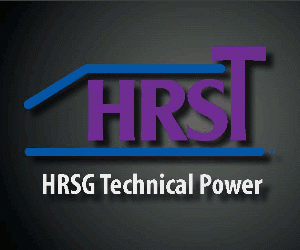GE Day during the Combined Cycle Users Group (CCUG) 2021 virtual conference began with a glimpse into the next 20-30 years of combined-cycle facility operations and ended with a tutorial in using historical data to trend the last 20 years of a plant’s operation. In-between were deep dives into BOP plant impacts from gas turbine (GT) technology upgrades and aggressive operating tempos, followed by solutions for those impacts on HRSGs, generators, and steam turbines.
The overarching message was that GE has the depth and breadth of expertise to, essentially, be your partner and keep you on-mission, in-market, and thriving, regardless of what challenges your plant faces in the coming years.
Think of it this way. If your primary-care physician designed your body and manufactured its components, you’d probably have a high level of trust that he/she could maintain it. As the OEM for the GT/generator, HRSG, and steam turbine (ST)/generator at many combined-cycle facilities worldwide, GE wants you to know that they have the fleet performance data, specialists who can analyze your plant-specific operating data, diagnostic capabilities, manufacturing capacity for replacement components, repair procedures, and technology upgrades to keep your plant surviving and thriving into the future.
Jeff Chann, business intelligence leader, talked about the realities of “obsessive carbon management” in the political and cultural realms and the inevitability of converting some of today’s GTs to burn different levels of hydrogen. He gave a candid review of the pros and cons of hydrogen and the need for carbon capture and storage if the hydrogen is produced through steam reforming rather than electrolysis powered by surplus renewable electricity and “really clean water.”
Example: The largest installed hydrogen storage facility in the US would be emptied in eight hours by an H- or J-class GT. Takeaway: The accompanying hydrogen production, storage, and delivery infrastructure need to be built out.
Chann rallied the audience by noting “existing plants will have to stick around longer to help” with the transition to a low-/no-carbon electricity future and that “we’re the ones with the technical expertise to enable hydrogen.” Queen’s “We are the Champions” could have been playing in the background.
Evaluating plant impacts. John Sholes, principal engineer, divided plant impacts into short-term (this year), mid-term (next major outage), and long-term (game-changer GT technology infusion). Examples:
-
- Long-term—full AGP upgrade for hot-day peaks and cold-day performance, along with identifying and addressing BOP (cooling tower, GSU/transformer, attemperator valves) limitations (Fig 1).
- Short-term—modifying controls and upgrading the attemperator to achieve 80% turndown (60% is considered typical for low-load operating plants today).
- Mid-term—upgrading the combustor with advanced gas path (AGP) technology and extended-turndown valves for the attemperator.
Matt Matthews, project engineering manager, delivered a case study of a winter-peak plant upgrade, timely given the catastrophic Ercot grid-wide winter outage this past February. Objective for this Ercot-based plant customer was a risk assessment targeting cold-plant operation. Matthews described the uprate as involving relatively small changes, such as boosting generator output by increasing hydrogen coolant pressure and higher horsepower motors for the boiler feedwater pumps. The plant will begin operations with the upgrades in the first quarter of 2022.
Harp replacements. Vasileios Kalos, platform leader, HRSG Services, cautioned the audience that off-spec operating conditions like sustained low-load operation and aggressive cycling accelerate life consumption of HRSG pressure parts. PPs operating under such conditions require more inspections and more repairs. Users considering replacing pressure parts need to think in terms of 12-month lead times and planning for “intensive field resources,” such as large cranes, and even temporary preservation of PPs onsite for up to 12 months.
Kalos supported his presentation with four case studies:
-
- Working with a user to create a “value story” for an HP evaporator replacement.
- Replacing HP evaporator and economizer harps damaged by a hydrotest. (Lesson learned: You can’t perform a 10-yr hydrotest on an older unit as if it were brand new.)
- Replacing HP superheater and reheater harps during a GT upgrade to extend HRSG life. Extensive cracking was discovered after 20 years of operation and daily start/stops.
- Replacing HP and IP economizer and evaporator harps damaged by corrosion because of improper preservation of pressure parts. User anticipated tube leaks and frequent forced outages as a result.
Generator lifecycle. Ian Hughes, principal engineer, Fleet Management, reviewed recommended maintenance and rewinds to avoid generator forced outages. To drive his main points home, Hughes noted that a planned stator rewind typically takes 28 days. Double that for an unplanned one.
Unplanned rewinds (Fig 2) are increasing, having doubled since 2011, he said, because of, you guessed it, larger load swings, more load swings, greater number of starts/stops, and time units are on turning gear. Generally, GE is not able to pinpoint the root cause of these rewind outages; years in service is the best predictor of need for a rewind.
Hughes dwelled on core step-iron damage at the turbine end for 7FH2 units shipped between 2001 and 2003, the subject of TIL-2260, including some outlier finds of missing teeth. These units represent 6% of the fleet. This type of damage is generally found on the GT generators, not the ST unit. He further noted that there are eight different design versions of the 7FH2 generator, and some of the components are not interchangeable.
Perhaps the most important part of Hughes’ talk was that the 1999-2002 GT supply bubble has led to a “rewind bubble” currently. By 2024, rewinding needs will exceed industry capacity, Hughes warned. GE has some exchange rotor fields for swap-outs but not many. He advised users to have stator and rotor bars “on-hand” as GE cannot, from a business perspective, carry too much inventory. “We have to shave the peak of this bubble,” he cautioned.
GE recommends flux-probe and PDA tests prior to an outage to detect potential damage and at least a one-year planning cycle for rotor/stator rewinds. GE also offers several M&D packages for generators which range from twice yearly inspections to 24/7/365 remote monitoring.
Cycling impacts on steam turbines. Matt Foreman, platform leader, Combined-Cycle Steam Turbine Services, carried on by reviewing the many ways cycling operations impact the steam turbine lifecycle (Fig 3). Major takeaway: Most ST components are “made to order,” only the last-stage blades have commonality, few components are stocked, and you should figure on an 18-month planning cycle prior to an outage. Regular inspection and maintenance are key to avoiding outage-inducing surprises.
Caught early, minor cracks, such as found in highly stressed components like main steam control valves, can be addressed through “grind and blend” repair techniques. As for a current common issue, diaphragm dishing,“ GE has been dealing with dishing for a long time in the D11 fleet,” Foreman said. However, he mentioned a relatively new impact—axial shell creep moving diaphragms downstream.
An important aspect of Foreman’s slides came at the end, when he showed several graphs (Fig 4) of long-term operating data (from the inception of commercial ops), and how data analysis also can identify minor issues before they become big ones. “Each unit has a unique operating history, and data mining can reveal trends important to a predictive maintenance strategy,” Foreman said.





